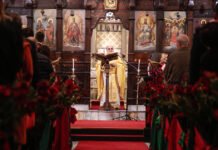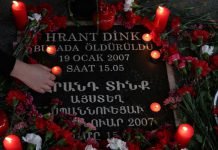George Aslan, a Turkish-Armenian deputy from the Peoples’ Equality and Democracy Party (DEM Party), submitted a parliamentary question seeking clarification on the accuracy of a report by the state-run Anadolu news agency claiming that a historic Armenian cathedral would be restored and reopened as a mosque.
According to a report by the Bianet news website, Turkey’s Armenian community is concerned that the Ani Cathedral, a site of deep historic and religious significance, may be converted into a mosque, resulting in the loss of a key symbol of their cultural heritage.
Ani is a ruined medieval Armenian city now located in Turkey’s eastern Kars province on the border with Armenia. The cathedral is the largest standing historic building in the region, with its history going back to the 11th century. After the region fell under Turkish rule in 1064, the cathedral was briefly converted into a mosque but later continued to function as a church.
However, the Anadolu report referred to the monument as the “Conquest Mosque” (Fethiye Camii) and said it would be reopened to visitors after the three-phase restoration, initiated by the Ministry of Culture and Tourism and the World Monuments Fund, was completed.
“Restoration work is ongoing at the Fethiye Mosque (Ani Cathedral), known as the first conquest mosque where the first Friday prayer [circa 1064] in Anatolia was performed, located in the Ani Ruins, a UNESCO World Heritage Site,” said the news report.
The report failed to acknowledge that the monument was only briefly a mosque and served as a cathedral for the Armenian community before falling into ruin after an earthquake in 1988.
Aslan asked whether claims that the Ani Cathedral would be reopened as a mosque following its restoration were true, and if so, what the justification was. He questioned whether altering the religious identity of this historic structure and converting it into a mosque contradicted Turkey’s multi-faith and multicultural character. Aslan also asked whether the decision to convert the Ani Cathedral into a mosque would be reconsidered in light of the site’s original religious and cultural significance. Additionally, he requested information on how many such conversions had taken place in the past 20 years.
Historian Ayşe Hür voiced strong opposition on social media to the possible conversion of the cathedral. Addressing Turkish authorities she said, “There are 85,000 mosques in this country, most of them without congregations. Do you still feel there’s a shortage? Let the thousand-year-old Ani Cathedral remain a cathedral or a cultural heritage site!”
In Turkey, several historic churches, particularly Byzantine-era structures in Istanbul, have been converted into mosques. The most prominent example is Hagia Sophia, which was originally a church, then a mosque, then a museum and recently converted back into a mosque. Another notable example is the Chora Church (Kariye Mosque), also in Istanbul, which has been similarly converted. These conversions have sparked debate about the preservation of Christian heritage in Turkey.















